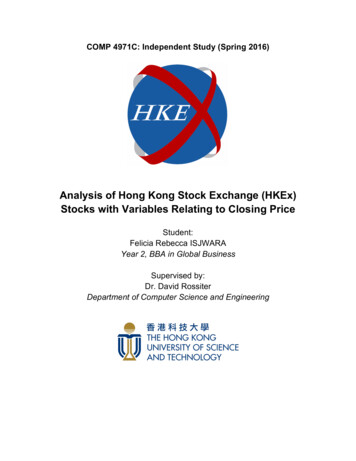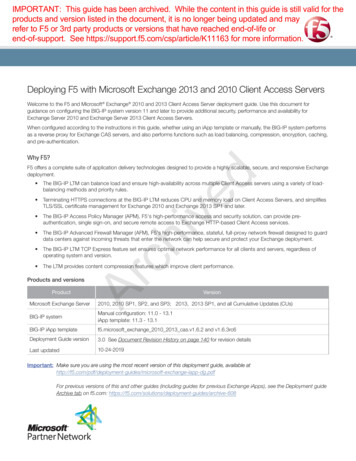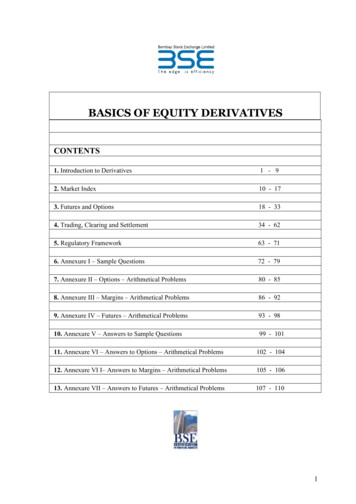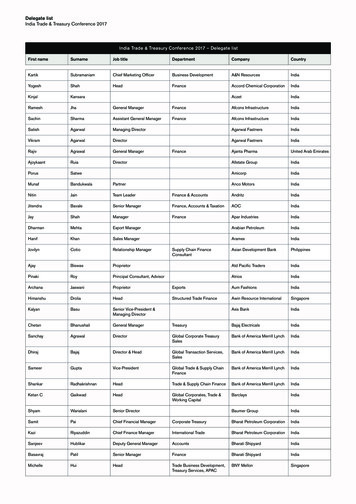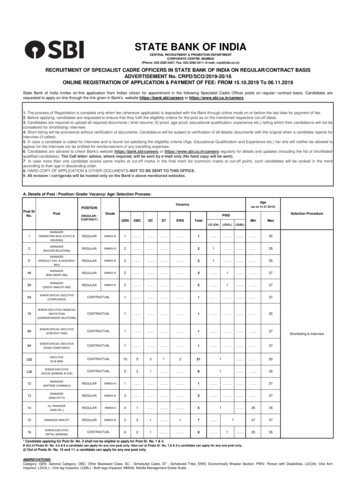
Transcription
Technical Analysis ModuleNATIONAL STOCK EXCHANGE OF INDIA LIMITED
Test Details:Sr.No.Name of ModuleFees(Rs.)Test Duration(in minutes)No. ofQuestionsMaximumMarksPassMarks (%)CertificateValidity51Financial Markets: A Beginners’ Module *168612060100502Mutual Funds : A Beginners' Module1686120601005053Currency Derivatives: A Beginner’s Module1686120601005054Equity Derivatives: A Beginner’s Module1686120601005055Interest Rate Derivatives: A Beginner’s Module1686120601005056Commercial Banking in India: A Beginner’s Module1686120601005057Securities Market (Basic) Module1686120601006058Capital Market (Dealers) Module *1686105601005059Derivatives Market (Dealers) Module * [Please refer to footnote no. (i) ]16861206010060310FIMMDA-NSE Debt Market (Basic) Module16861206010060511Investment Analysis and Portfolio Management Module16861206010060512Fundamental Analysis Module16861206010060513Financial Markets (Advanced) Module16861206010060514Securities Markets (Advanced) Module16861206010060515Mutual Funds (Advanced) Module16861206010060516Banking Sector Module16861206010060517Insurance Module16861206010060518Macroeconomics for Financial Markets Module16861206010060519Mergers and Acquisitions Module16861206010060520Back Office Operations Module16861206010060521Wealth Management Module16861206010060522NISM-Series-I: Currency Derivatives Certification Examination100012010010060323NISM-Series-II-A: Registrars to an Issue and Share Transfer Agents –Corporate Certification ExaminationNISM-Series-II-B: Registrars to an Issue and Share Transfer Agents –Mutual Fund Certification M-Series-IV: Interest Rate Derivatives Certification Examination100012010010060326NISM-Series-V-A: Mutual Fund Distributors Certification Examination *100012010010050327NISM-Series-VI: Depository Operations Certification M Series VII: Securities Operations and Risk ManagementCertification ExaminationNISM-Series-VIII: Equity Derivatives Certification Examination100012010010060330Certified Personal Financial Advisor (CPFA) Examination44951208010060331NSDL–Depository Operations Module1686756010060 #532Commodities Market Module20221206010050333Surveillance in Stock Exchanges Module16861205010060534Corporate Governance Module16869010010060535Compliance Officers (Brokers) Module16861206010060536Compliance Officers (Corporates) Module16861206010060537Information Security Auditors Module (Part-1)Information Security Auditors Module (Part-2)2528252812012090901001006060238Options Trading Strategies Module16861206010060539Options Trading (Advanced) Module16861203510060540FPSB India Exam 1 to 4**2247 perexam1207514060NA41Examination 5/Advanced Financial Planning **56182403010050NA42Equity Research Module ##16861206510055243Issue Management Module ##16861208010055244Market Risk Module ##16861205010055245Financial Modeling Module ###11231203010050NA46Financial Services Foundation Module ###11231204510050NA*#**Candidates have the option to take the tests in English, Gujarati or Hindi languages.Candidates securing 80% or more marks in NSDL-Depository Operations Module ONLY will be certified as ‘Trainers’.Following are the modules of Financial Planning Standards Board India (Certified Financial Planner Certification)FPSB India Exam 1 to 4 i.e. (i) Risk Analysis & Insurance Planning (ii) Retirement Planning & Employee Benefits (iii) InvestmentPlanning and (iv) Tax Planning & Estate PlanningExamination 5/Advanced Financial Planning## Modules of Finitiatives Learning India Pvt. Ltd. (FLIP)### Module of IMS ProschoolThe curriculum for each of the modules (except Modules of Financial Planning Standards Board India, Finitiatives Learning India Pvt. Ltd. andIMS Proschool) is available on our website: www.nseindia.com Education Certifications.Note: (i) NISM has specified the NISM-Series-VIII-Equity Derivatives Certification Examination as the requisite standard for associated personsfunctioning as approved users and sales personnel of the trading member of an equity derivatives exchange or equity derivative segment of arecognized stock exchange.
ContentsCHAPTER 1 . 9INTRODUCTION TO TECHNICAL ANALYSIS . 91.1What is technical analysis?.91.1.1Price discounts everything .91.1.2Price movements are not totally random . 101.1.3Technical Analysis: the basic assumption . 111.1.4Strengths and weakness of technical analysis . 121.1.4.1Importance of technical analysis. 121.1.4.2Weaknesses of technical analysis . 13CHAPTER 2 . 16CANDLE CHARTS . 162.1The charts . 162.2Candlestick analysis . 202.2.12.2.22.2.3One candle pattern. 212.2.1.1Hammer . 212.2.1.2Hanging man . 222.2.1.3Shooting star and inverted hammer . 23Two candle pattern . 262.2.2.1Bullish engulfing. 262.2.2.2Bearish engulfing . 282.2.2.3Piercing . 292.2.2.4Bearish harami. 312.2.2.5Bullish harami . 33Three candle pattern . 352.2.3.1Evening star . 352.2.3.2Morning star . 382.2.3.3Doji . 40CHAPTER 3 . 46PATTERN STUDY . 463.1What are support and resistance lines? . 463.1.1Support. 463.1.2Resistance . 483.1.3Why do support and resistance lines occurs?. 493.1.4Support and resistance zone . 493.1.5Change of support to resistance and vice versa . 513
3.1.63.23.33.4Why are support and resistance lines important? . 52Head and shoulders . 523.2.1Head and shoulders top reversal . 533.2.2Inverted head and shoulders . 573.2.3Head and shoulders bottom . 58Double top and double bottom . 623.3.1Double top . 633.3.2Double bottom. 663.3.3Rounded top and bottom . 69Gap theory . 703.4.1Common gaps . 713.4.2Breakaway gaps. 713.4.3Runaway/continuation gap . 723.4.4Exhaustion gap . 733.4.5Island cluster . 74CHAPTER 4 . 79MAJOR INDICATORS & OSCILLATORS . 794.14.24.3What does a technical indicator offer? . 794.1.1Why use indicator? . 794.1.2Tips for using indicators . 794.1.3Types of indicators . 804.1.4Simple moving average. 814.1.5Exponential moving average . 814.1.6Which is better? . 83Trend following indicator . 844.2.1When to use? . 844.2.2Moving average settings . 844.2.3Uses of moving average . 854.2.4Signals - moving average price crossover . 874.2.5Signals - multiple moving averages . 88Oscillators . 894.3.1Relative strength index . 894.3.1.1What is momentum? . 894.3.1.2Applications of RSI . 904.3.1.3Overbought and oversold . 904.3.1.4Divergence . 914.3.1.5Stochastic . 934
4.3.24.44.3.1.6William %R . 974.3.1.7Real life problems in use of RSI . 994.3.1.8Advanced concepts . 99Moving average convergence/divergence(MACD) . 1024.3.2.1What is the macd and how is it calculated . 1024.3.2.2MACD benefits . 1034.3.2.3uses of MACD . 1044.3.2.4Money Flow Index . 1074.3.2.5Bollinger Bands . 109Using multiple indicators for trading signals. 1104.4.1Price sensitive techniques. 1104.4.2Volume sensitive techniques . 1114.4.3Composite methods . 1114.4.4How to use tool kit of trading techniques . 1114.4.5Trading market tool kit applications . 1124.4.6Bull market tool kit application . 1124.4.7Bear market tool kit application. 1124.4.8Trading market changing to bull market tool kit application . 1134.4.9Trading market changing to bear market tool kit application . 1134.4.10 Bull market changing to trading market tool kit application . 1144.4.11 Bear market changing to trading market tool kit application . 114Chapter 5 . 120Trading Strategies . 1205.15.2day trading . 1205.1.1advantages of day trading . 1205.1.2risks associated with risk trading . 121strategies . 1235.2.1strategies for day trading . 1235.2.2momentum trading strategies . 123Chapter 6 . 127Dow Theory and Elliott Wave Theory . 1276.1Introduction . 1276.2Principles of Dow Theory . 1276.3Significance of Dow Theory . 1336.4Problems with Dow Theory . 1336.5Elliot Wave . 1336.5.1Introduction . 1336.5.2Fundamental Concept . 1335
6.5.3After Elliott. 149Chapter 7 . 159Trading psychology and risk management . 1597.1Introduction . 1597.2Risk Management . 1607.2.1Components of risk management . 1617.2.1.1Stop loss . 1617.2.1.2Analyze reward risk ratio . 1617.2.1.3Trail stop loss. 1617.2.1.4Booking Profit . 1617.2.1.5uses of stop loss . 1617.2.1.6qualities of successful traders . 1617.2.1.7golden rules of traders . 1627.2.1.8do’s and don’ts in trading . 1627.3rules to stop losing money . 1637.4choosing the right market to trade . 1677.4.1importance of discipline in trading . 1676
Distribution of weights in theTechnical Analysis Module CurriculumChapterNo.TitleWeightages1INTRODUCTION TO TECHNICAL ANALYSIS122CANDLE CHARTS133PATTERN STUDY204MAJOR INDICATORS & OSCILLATORS205TRADING STRATEGIES126DOW THEORY AND ELLIOT WAVE THEORY127TRADING PSYCHOLOGY AND RISK MANAGEMENT11Total100Note: Candidates are advised to refer to NSE’s website: www.nseindia.com, click on ‘Education’link and then go to ‘Updates & Announcements’ link, regarding revisions/updations in NCFMmodules or launch of new modules, if any.Copyright 2013 by National Stock Exchange of India Ltd. (NSE)Exchange Plaza, BandraKurla Complex,Bandra (East), Mumbai 400 051 INDIAAll content included in this book, such as text, graphics, logos, images, data compilation etc.are the property of NSE. This book or any part thereof should not be copied, reproduced,duplicated, sold, resold or exploited for any commercial purposes. Furthermore, the book inits entirety or any part cannot be stored in a retrieval system or transmitted in any form or byany means, electronic, mechanical, photocopying, recording or otherwise.7
8
CHAPTER 1INTRODUCTION TO TECHNICALANALYSISLearning objectivesAfter studying this chapter the student should be able to understand: The basis of technical analysis The strengths and weaknesses of technical analysis1.1What is Technical Analysis?Technical Analysis can be defined as an art and science of forecasting future prices based onan examination of the past price movements. Technical analysis is not astrology for predictingprices. Technical analysis is based on analyzing current demand-supply of commodities,stocks, indices, futures or any tradable instrument.Technical analysis involve putting stock information like prices, volumes and open intereston a chart and applying various patterns and indicators to it in order to assess the futureprice movements. The time frame in which technical analysis is applied may range fromintraday (1-minute, 5-minutes, 10-minutes, 15-minutes, 30-minutes or hourly), daily, weeklyor monthly price data to many years.There are essentially two methods of analyzing investment opportunities in the securitymarket viz fundamental analysis and technical analysis. You can use fundamental informationlike financial and non-financial aspects of the company or technical information which ignoresfundamentals and focuses on actual price movements.The basis of Technical AnalysisWhat makes Technical Analysis an effective tool to analyze price behavior is explained byfollowing theories given by Charles Dow: Price discounts everything Price movements are not totally random What is more important than why1.1.1Price discounts everything“Each price represents a momentary consensus of value of all market participants – largecommercial interests and small speculators, fundamental researchers, technicians andgamblers- at the moment of transaction” – Dr Alexander Elder9
Technical analysts believe that the current price fully reflects all the possible materialinformation which could affect the price. The market price reflects the sum knowledge ofall participants, including traders, investors, portfolio managers, buy-side analysts, sell-sideanalysts, market strategist, technical analysts, fundamental analysts and many others. Itwould be folly to disagree with the price set by such an impressive array of people withimpeccable credentials. Technical analysis looks at the price and what it has done in the pastand assumes it will perform similarly in future under similar circumstances. Technical analysislooks at the price and assumes that it will perform in the same way as done in the past undersimilar circumstances in future.1.1.2Price movements are not totally randomTechnical analysis is a trend following system. Most technicians acknowledge that hundredsof years of price charts have shown us one basic truth – prices move in trends. If prices werealways random, it would be extremely difficult to make money using technical analysis. Atechnician believes that it is possible to identify a trend, invest or trade based on the trendand make money as the trend unfolds. Because technical analysis can be applied to manydifferent time frames, it is possible to spot both short-term and long-term trends.“What” is more important than “Why”It is said that “A technical analyst knows the price of everything, but the value of nothing”.Technical analysts are mainly concerned with two things:1.The current price2.The history of the price movementAll of you will agree that the value of any asset is only what someone is willing to pay forit. Who needs to know why? By focusing just on price and nothing else, technical analysisrepresents a direct approach. The price is the final result of the fight between the forces ofsupply and demand for any tradable instrument. The objective of analysis is to forecast thedirection of the future price. Fundamentalists are concerned with why the price is what it is.For technicians, the why portion of the equation is too broad and many times the fundamentalreasons given are highly suspect. Technicians believe it is best to concentrate on what andnever mind why. Why did the price go up? It is simple, more buyers (demand) than sellers(supply).The principles of technical analysis are universally applicable. The principles of support,resistance, trend, trading range and other aspects can be applied to any chart. Technicalanalysis can be used for any time horizon; for any marketable instrument like stocks, futuresand commodities, fixed-income securities, forex, etc10
Top-down Technical AnalysisTechnical analysis uses top-down approach for investing. For each stock, an investor wouldanalyze long-term and short-term charts. First of all you will consider the overall market, mostprobably the index. If the broader market were considered to be in bullish mode, analysiswould proceed to a selection of sector charts. Those sectors that show the most promisewould be selected for individual stock analysis. Once the sector list is narrowed to 3-5 industrygroups, individual stock selection can begin. With a selection of 10-20 stock charts from eachindustry, a selection of 3-5 most promising stocks in each group can be made. How manystocks or industry groups make the final cut will depend on the strictness of the criteria setforth. Under this scenario, we would be left with 9-12 stocks from which to choose. Thesestocks could even be broken down further to find 3-4 best amongst the rest in the lot.1.1.3Technical Analysis: The basic assumptionsThe field of technical analysis is based on three assumptions:1. The market discounts everything.2. Price moves in trends.3. History tends to repeat itself.1. The market discounts everythingTechnical analysis is criticized for considering only prices and ignoring the fundamental analysisof the company, economy etc. Technical analysis assumes that, at any given time, a stock’sprice reflects everything that has or could affect the company - including fundamental factors.The market is driven by mass psychology and pulses with the flow of human emotions.Emotions may respond rapidly to extreme events, but normally change gradually over time.It is believed that the company’s fundamentals, along with broader economic factors andmarket psychology, are all priced into the stock, removing the need to actually consider thesefactors separately. This only leaves the analysis of price movement, which technical theoryviews as a product of the supply and demand for a particular stock in the market.2. Price moves in trends“Trade with the trend” is the basic logic behind technical analysis. Once a trend has beenestablished, the future price movement is more likely to be in the same direction as the trendthan to be against it. Technical analysts frame strategies based on this assumption only.3. History tends to repeat itselfPeople have been using charts and patterns for several decades to demonstrate patterns inprice movements that often repeat themselves. The repetitive nature of price movements11
is attributed to market psychology; in other words, market participants tend to provide aconsistent reaction to similar market stimuli over time. Technical analysis uses chart patternsto analyze market movements and understand trends.1.1.4Strengths and weakness of Technical Analysis1.1.4.1 Importance of Technical AnalysisNot Just for stocksTechnical analysis has universal applicability. It can be applied to any financial instrument stocks, futures and commodities, fixed-income securities, forex, etcFocus on priceFundamental developments are followed by price movements. By focusing only on price action,technicians focus on the future. The price pattern is considered as a leading indicator andgenerally leads the economy by 6 to 9 months. To track the market, it makes sense to lookdirectly at the price movements. More often than not, change is a subtle beast. Even thoughthe market is prone to sudden unexpected reactions, hints usually develop before significantmovements. You should refer to periods of accumulation as evidence of an impending advanceand periods of distribution as evidence of an impending decline.Supply, demand, and price actionTechnicians make use of high, low and closing prices to analyze the price action of a stock. Agood analysis can be made only when all the above information is presentSeparately, these will not be able to tell much. However, taken together, the open, high, lowand close reflect forces of supply and demand.Support and resistanceCharting is a technique used in analysis of support and resistance level. These are tradingrange in which the prices move for an extended period of time, saying that forces of demandand supply are deadlocked. When prices move out of the trading range, it signals that eithersupply or demand has started to get the upper hand. If prices move above the upper band ofthe trading range, then demand is winning. If prices move below the lower band, then supplyis winning.Pictorial price historyA price chart offers most valuable information that facilitates reading historical account ofa security’s price movement over a period of time. Charts are much easier to read than atable of numbers. On most stock charts, volume bars are displayed at the bottom. With thishistorical picture, it is easy to identify the following:12
Market reactions before and after important events Past and present volatility Historical volume or trading levels Relative strength of the stock versus the index.Assist with entry pointTechnical analysis helps in tracking a proper entry point. Fundamental analysis is used todecide what to buy and technical analysis is used to decide when to buy. Timings in thiscontext play a very important role in performance. Technical analysis can help spot demand(support) and supply (resistance) levels as well as breakouts. Checking out for a breakoutabove resistance or buying near support levels can improve returns.First of all you should analyze stock’s price history. If a stock selected by you was great forthe last three years has traded flat for those three years, it would appear that market has adifferent opinion. If a stock has already advanced significantly, it may be prudent to wait for apullback. Or, if the stock is trending lower, it might pay to wait for buying interest and a trendreversal.1.1.4.2 Weaknesses of Technical AnalysisAnalyst biasTechnical analysis is not hard core science. It is subjective in nature and your personal biasescan be reflected in the analysis. It is important to be aware of these biases when analyzinga chart. If the analyst is a perpetual bull, then a bullish bias will overshadow the analysis.On the other hand, if the analyst is a disgruntled eternal bear, then the analysis will probablyhave a bearish tilt.Open to interpretationTechnical analysis is a combination of science and art and is always open to interpretation.Even though there are standards, many times two technicians will look at the same chartand paint two different scenarios or see different patterns. Both will be able to come up withlogical support and resistance levels as well as key breaks to justify their position. Is the cuphalf-empty or half-full? It is in the eye of the beholder.Too lateYou can criticize the technical analysis for being too late. By the time the trend is identified, asubstantial move has already taken place. After such a large move, the reward to risk ratio isnot great. Lateness is a particular criticism of Dow Theory.13
Always another levelTechnical analysts always wait for another new level. Even after a new trend has been identified,there is always another “important” level close at hand. Technicians have been accused ofsitting on the fence and never taking an unqualified stance. Even if they are bullish, there isalways some indicator or some level that will qualify their opinion.Trader’s remorseAn array of pattern and indicators arises while studying technical analysis. Not all the signalswork. For instance: A sell signal is given when the neckline of a head and shoulder
Test Details: * Candidates have the option to take the tests in English, Gujarati or Hindi languages. # Candidates securing 80% or more marks in NSDL-Depositor

